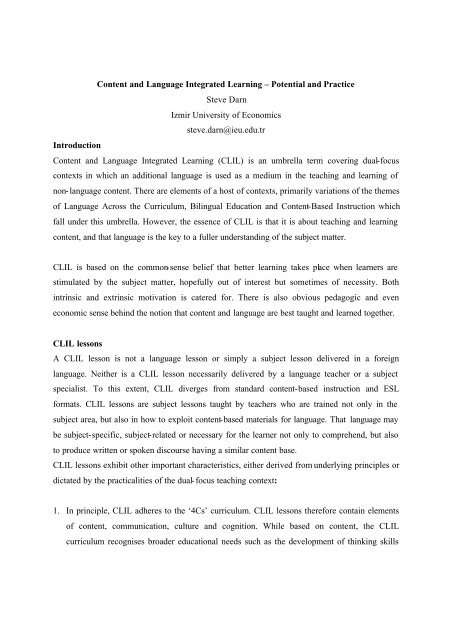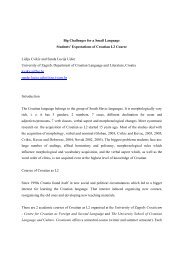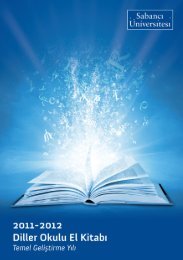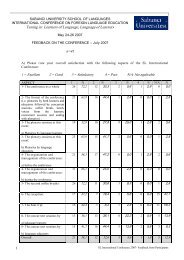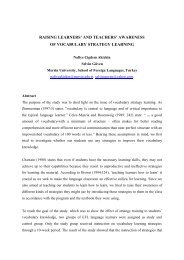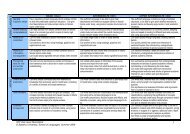Content and Language Integrated Learning Potential and Practice
Content and Language Integrated Learning Potential and Practice
Content and Language Integrated Learning Potential and Practice
Create successful ePaper yourself
Turn your PDF publications into a flip-book with our unique Google optimized e-Paper software.
<strong>Content</strong> <strong>and</strong> <strong>Language</strong> <strong>Integrated</strong> <strong>Learning</strong> – <strong>Potential</strong> <strong>and</strong> <strong>Practice</strong>Steve DarnIzmir University of Economicssteve.darn@ieu.edu.trIntroduction<strong>Content</strong> <strong>and</strong> <strong>Language</strong> <strong>Integrated</strong> <strong>Learning</strong> (CLIL) is an umbrella term covering dual-focuscontexts in which an additional language is used as a medium in the teaching <strong>and</strong> learning ofnon-language content. There are elements of a host of contexts, primarily variations of the themesof <strong>Language</strong> Across the Curriculum, Bilingual Education <strong>and</strong> <strong>Content</strong>-Based Instruction whichfall under this umbrella. However, the essence of CLIL is that it is about teaching <strong>and</strong> learningcontent, <strong>and</strong> that language is the key to a fuller underst<strong>and</strong>ing of the subject matter.CLIL is based on the common-sense belief that better learning takes place when learners arestimulated by the subject matter, hopefully out of interest but sometimes of necessity. Bothintrinsic <strong>and</strong> extrinsic motivation is catered for. There is also obvious pedagogic <strong>and</strong> eveneconomic sense behind the notion that content <strong>and</strong> language are best taught <strong>and</strong> learned together.CLIL lessonsA CLIL lesson is not a language lesson or simply a subject lesson delivered in a foreignlanguage. Neither is a CLIL lesson necessarily delivered by a language teacher or a subjectspecialist. To this extent, CLIL diverges from st<strong>and</strong>ard content-based instruction <strong>and</strong> ESLformats. CLIL lessons are subject lessons taught by teachers who are trained not only in thesubject area, but also in how to exploit content-based materials for language. That language maybe subject-specific, subject-related or necessary for the learner not only to comprehend, but alsoto produce written or spoken discourse having a similar content base.CLIL lessons exhibit other important characteristics, either derived from underlying principles ordictated by the practicalities of the dual-focus teaching context:1. In principle, CLIL adheres to the ‘4Cs’ curriculum. CLIL lessons therefore contain elementsof content, communication, culture <strong>and</strong> cognition. While based on content, the CLILcurriculum recognises broader educational needs such as the development of thinking skills
<strong>and</strong> self-awareness, <strong>and</strong> exposure to alternative cultural perspectives. CLIL is committed tobreadth of education, long-term learning <strong>and</strong> internationalisation.2. In using language to learn while learning to use language, it is the subject matter whichdetermines the language to be learnt. There is no language syllabus, <strong>and</strong> language within atext is not graded. Naturally, more content is learned as language competence increases.<strong>Language</strong> is seen as a means to the end of learning content, <strong>and</strong> language is integrated intothe broad curriculum.3. CLIL lessons incorporate all four language skills, but are often based on reading texts as themajor source of input. <strong>Language</strong> learning in the CLIL context bears similarities to currentELT practice in that lessons tend to be of the integrated skills type, language is approachedlexically rather than grammatically <strong>and</strong> language is noticed <strong>and</strong> explored rather than taught.Errors are seen as part of a natural progression, <strong>and</strong> functional language is of a high priority.Learner styles are taken into account in task types. <strong>Language</strong> learning in CLIL, therefore, isnot far removed from the humanistic, communicative <strong>and</strong> lexical approaches commonly seenin ELT.Lesson frameworkWhile there is no such thing as a ‘CLIL lesson’, the following four-stage format is often followedin order to provide a balance of content <strong>and</strong> language:1. Processing the text. When working in a foreign language, learners need structural markers intexts to help them find their way through the content. These markers may be linguistic(headings, sub-headings) <strong>and</strong>/or diagrammatic. Once a 'core knowledge' has been identified,the organisation of the text can be analysed.2. Identification <strong>and</strong> organisation of knowledge. Texts are often represented diagrammatically.These structures are known as 'ideational frameworks' or 'diagrams of thinking', <strong>and</strong> are usedto help learners categorise the ideas <strong>and</strong> information in a text. Diagram types include treediagrams for classification, groups, hierarchies, flow diagrams <strong>and</strong> timelines for sequencedthinking such as instructions <strong>and</strong> historical information, tabular diagrams describing people2
dem<strong>and</strong>, with short courses being available in the UK at institutions such as Pilgrims <strong>and</strong> theNorwich Institute for <strong>Language</strong> Education (NILE).CLIL offers opportunities for team teaching <strong>and</strong> cooperation between language <strong>and</strong> subjectteachers. Where skills for life are the aim, the ideal situation is the involvement of subject <strong>and</strong>language teachers together with a vocational trainer. In a cooperative environment, motivation forteaching increases, each discipline benefits, teachers exp<strong>and</strong> their repertoire of teachingtechniques, <strong>and</strong> mutual respect develops between teachers of various disciplines.CLIL progressOver the past five years, CLIL has spread from its roots in Western Europe, particularlySc<strong>and</strong>inavia, to many countries in Europe, Asia, Africa, South America <strong>and</strong> the Far East . Insome countries such as the USA there has been a tradition of content-based teaching, immersionprograms <strong>and</strong> language learning in mainstream classrooms, while in Europe, many projects aredriven by the EU’s long term vision of a plurilingual society. In South America, particularlyBrazil, CLIL is seen as an economical alternative to providing language instruction for very largenumbers of students. In Africa, there are CLIL projects which have a socio-political objective inreducing racial <strong>and</strong> social inequalities. In the UK, where language has become a priority in thenational curriculum, there are local <strong>and</strong> regional projects ranging from the teaching of science inFrench in elementary schools to providing language support for immigrants <strong>and</strong> refugees in thesecondary <strong>and</strong> vocational sectors.ObstaclesIn many ways, CLIL remains embryonic. There is inevitable opposition to language teaching bysubject teachers, while language teachers may foresee the end of the language classroom as weknow it. There are also those who believe that the spread of CLIL is being driven by political <strong>and</strong>economic forces which may be temporary. Meanwhile, the majority of CLIL projects areexperimental <strong>and</strong> there is a lack of empirical data by which success can be measured. CLILtraining courses are few, <strong>and</strong> materials <strong>and</strong> resources scarce. ‘Teaching English Through Other4
Subjects’ (Sheelagh Deller <strong>and</strong> Christine Price, OUP 2007) is the first CLIL resource book froma major ELT publisher. Assessment is also a problematic area, given that content <strong>and</strong> languageneed to be given equal weighting. There are ongoing debates regarding the language acquisitionaspect of CLIL learning, <strong>and</strong> over how far subject comprehension may be impeded by inadequatelanguage competence. Critics, however, are faced with the potential of CLIL as long termlearning starting in elementary school, <strong>and</strong> the inevitable dem<strong>and</strong>s of internationalisation forefficient <strong>and</strong> economical ways of achieving bilingualism or multilingualism.CLIL in TurkeyCLIL may be a way forward for language learning in Turkey, where English has been the pivotalsubject in the curriculum for some time. There is already a history of content based teaching <strong>and</strong>learning of mathematics <strong>and</strong> science in private high schools, while English medium universitiescurrently proliferate. CLIL offers the opportunity to address the lack of vocationally orientedteaching in higher education, <strong>and</strong> the possibility of shifting more content learning into universityfoundation courses, which are currently almost exclusively language based. Learner motivation isa constant problem in a system in which students arrive at university having already studiedEnglish for several years <strong>and</strong> are faced with the prospect of yet mo re general English <strong>and</strong> EAPcourses lacking a specific subject focus. While Turkey remains committed to membership of theEU, it may be well to remember that the dem<strong>and</strong> for a mobile labour force may be largelyconfined to language competent skilled labour rather than the academically adept.Essential WebsitesThere is a growing volume of literature concerning the nature <strong>and</strong> spread of CLIL. The followingfour Websites are good places to start:• http://www.clilcompendium.com/• http://www.clil-axis.net/• http://www.clilcom.stadia.fi/1500• http://www.factworld.info/5


